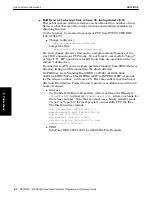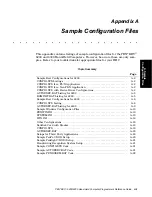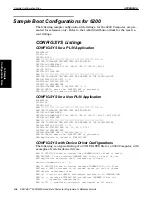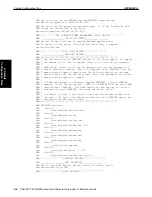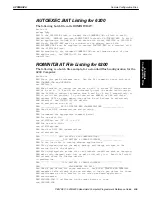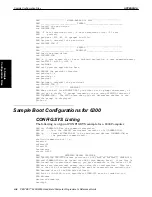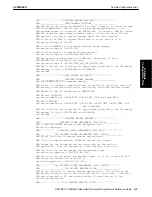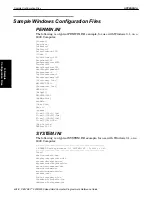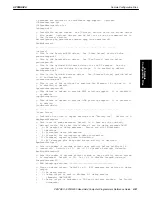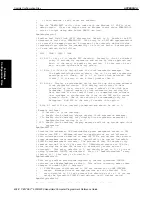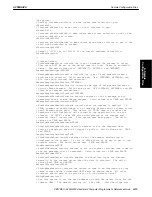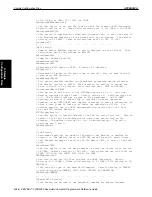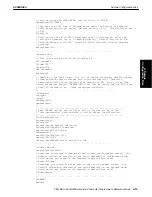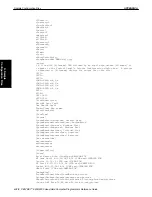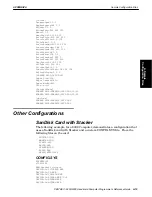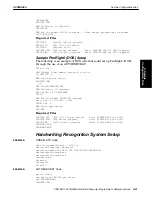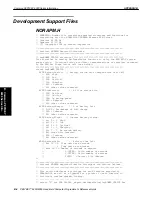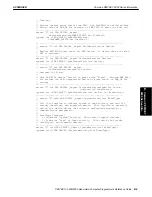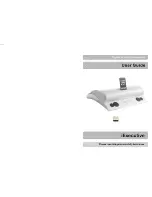
APPENDIX A
Sample Configuration Files
A-12 PEN*KEY
R
6200/6300 Hand-Held Computer Programmer’s Reference Guide
; 3: Both methods 1 and 2 above are enabled.
;
; Run the “DBWIN.EXE” utility that comes with the Windows 3.1 SDK to view
; debug output. Clear one output error as Windows starts since NORAPM.DLL
; tries to output debug data before DBWIN can load.
ApmDebugOutput=0
; Enables Real Time Clock (RTC) diagnostics. Default is 0. Enables the RTC
; diagnostics built into NORAPM.DLL. This entry is a DECIMAL representation
; of several bit-mapped options. A diagram of the currently defined fields
; (separated into nibbles for readability) is laid out below. A description
; of each defined field follows:
;
; 0000 | 000M | 0000 | LLLE
;
;
E) Bit 0: Set to 1 to enable RTC checking. Currently, clock is checked
;
every 10 seconds for regression and writes by other applications.
;
Add 1 to the entry to enable this setting. If this entry is not
;
set, no other options have any effect.
;
;
L) Bits 1–3: Sets the dialog level for clock regression messages. See
;
the ApmEventDialogs setting above. Set to 0 to enable regression
;
warnings at all times. Set to 1–7 to limit clock warnings. Add
;
(level * 2) to entry to set a level greater than 0.
;
;
M) Bit 8: Display a system-model dialog and lock up the system whenever
;
clock regression occurs. This setting could result in data
;
corruption or loss, since it forces a reboot if the clock goes
;
backwards. Typical causes of clock regression are setting the
;
date and time via the Control Panel, or communications software
;
that attempts to synchronize the clock on the HHC with a remote
;
system’s clock. Use of this setting is recommended only for
;
debugging. Add 256 to the entry to enable this option.
;
;
Bits 4–7 and 9–15 are currently undefined and should be set to 0.
;
; Example settings:
;
0: Default, no clock checking.
;
1: Enable clock checking, always display clock regression messages.
;
15: Enable clock checking, only display clock regression messages if
;
ApmEventDialogs setting is >= 7.
;
257: Enable clock checking, display message and lock up system upon clock
;
regression.
ApmCheckRTC=0
; Disables the broadcast of Norand-defined power management events to DOS
; drivers and TSR’s. Windows drivers and applications are not affected.
; This sidesteps broken behavior in some DOS TSR’s and drivers that monitor
; power management event broadcasts. Specifically the current SystemSoft
; PCMCIA card management software. The problem is that DOS drivers only
; examine bottom 8 bits of the event ID. OEM-defined events are 16 bits,
; thus causing the broken DOS drivers to misidentify events and act
; strangely. This entry defaults to 1, but should be set to 0, if you are
; using SystemSoft PCMCIA card drivers. Also, if “ApmFixSystemSoft” entry
; (below) is 1, this entry is forced to 0.
ApmDosOemEvents=0
; This entry enables workarounds required by current SystemSoft PCMCIA
; software (see ApmDosOemEvents above). This switch currently makes these
; changes to normal APM 1.1 behavior:
;
1. SUSPEND event notifications to DOS are converted to USER_SUSPEND
;
events. Windows drivers and applications are not affected. This
;
entry defaults to 0 if not present but should be set to 1 if you are
;
using the SystemSoft PCMCIA card drivers, until further notice.
ApmFixSystemSoft=1
;– – – – – – – – – – – – – – – – – – – – – – – – – – – – – – –
A. Sample
Configuration Files

